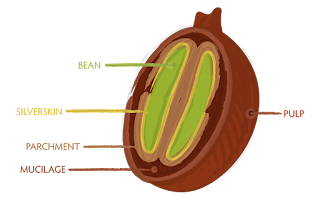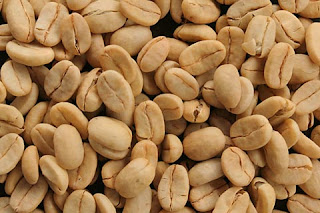The Creation of your Lovely Cup Coffee
As I promised before, I would tell you about the production of coffee. Now I will tell you.
Please note that most pictures are from an internet source,
and only are used as a visual support.
Please note that most pictures are from an internet source,
and only are used as a visual support.
 |
| Ready! |
The Creation of your Lovely Cup Coffee
Producing the coffee bean
 |
| Ripe coffee cherries |
 |
| Green coffee cherries not yet ready to harvest. The beans aren't fully developed yet. |
In order to get a coffee bean in the first place, you need to plant the coffee plants. There are special coffee farms who produce coffee seeds (unprocessed coffee "beans"). The beans used to make coffee are actually coffee seeds. The farm I went to was one of those coffee seed producing farms. Seedlings are nursed in large shaded beds and will be watered frequently and protected form bright sunlight till the are strong enough to plant. Planting happens mostly during the wet season when the soil is moist. Coffee plants are mostly planted there where they aren't exposed to bright sunlight for a whole day. You will find some trees between the coffee plants to provide some shady area's. It is believed that shadow grown coffee beans have a better final quality than fully sun grown beans. Although shadow grown coffee is less productive than sun grown. Some small farms are experimenting this by shading the plant at peak sun hours. Now Mexico is the largest shaded organic coffee producer, while Brazil is in general the largest coffee producer only most of it sun grown. Source
 |
| Coffee farm in Araponga (hope I will go there one day) Credits to: José Mario |
There are between 25 to 100 species of coffee
plants estimated, but there are actually two species that are used for large
scale coffee production. One is the Coffea
Arabica they have a delicious sophisticated fragrance, a gentle and soft flavor. Also, the acidity is higher in the Arabica bean. As in the case of coffee this is a good thing. The Arabica plant has many variaties of coffee plant breeds.
The second one is Coffea canephora var. Robusta, it is much easier to grow and has a very strong and is full of flavor. The taste is more bitter, that is why they are more used in melanges. The Robusta beans also have a higher content of caffeine.
Harvest
The second one is Coffea canephora var. Robusta, it is much easier to grow and has a very strong and is full of flavor. The taste is more bitter, that is why they are more used in melanges. The Robusta beans also have a higher content of caffeine.
 |
| Difference between Arabica and Robusta coffee beans |
Mostly it takes about 3 - 4 years till a plant starts to bear fruits. The fruit (called coffee cherry) is ripe when it is bright deep red or yellow (depends on breed of coffee plant). Some countries know 2 harvesting periods, in Brazil there is only 1 harvest period. In most coffee producing countries the cherries are hand picked, in Brazil they use mechanical harvesting techniques because the area's are much bigger. And on most flat terrains in Brazil, harvest is even performed bij an automatic machine which drives over the coffee plants.
 |
| Maquina de Colher Cafe |
While harvesting, there are 2 options:
Strip picking: cherries are stripped off the branche at one time, either by machine or by hand.
Or
Selectively picking: cherries are hand picked individually. You can imagine this is a very labor intensive process. That is why it is mainly used for the better Arabica beans. A good picker picks approximately 45 - 90 kg/day.
Before we go into detail, it is important that you know a bit what the anatomy is of a coffee cherry. Nothing special to it, just to understand the story below better remember the names of the picture below.
 |
| Anatomy of a coffee cherry |
Processing of the cherries
It is important to process the cherries as soon as possible, to avoid fungus attacks and quality loss. There are 2 options to process the cherries, dry method and wet method. But before using one of the two methods, the cherries are separated by using the difference in density in water (ripe cherries are heavier than unripe cherries) and leaves and twigs are removed. Because this preparation uses a lot of water, the cherries are also washed at the same time.
Dry method:
The cherries are directly after harvest dried as a whole fruit, they are mostly sun dried on patio's (large area's of mostly concrete floors). To avoid quality loss, the cherries are turn several times a day. During night and rain the are covered to prevent them from getting wet. The cherries are dried to a moisture content of approximately 11%. This process mostly takes up to 15 - 20 days. But drying can also be done with mechanical dryers. Again it is believed that the classical way of drying (sun dried) can deliver the really good quality of coffee, but if mechanical drying is performed correctly it can deliver even better quality than sun dried coffee. Also, the quality of patio drying is very difficult to guarantee. Source
 |
| Dried whole coffee fruits |
 |
| Concrete patio for sun drying of: coffee cherries or parchment coffee |
Wet method:
The cherries are pulped, the pulp is removed by a pulping machine. This separate the cherry pulp from the coffee bean with parchment (parchment coffee). The machine pushes the cherries through a small channel so the pulp slips of the bean. After pulping, there remains a sticky (mucilage) layer on the parchment. This is removed by either a demucilaging machine or fermentation and after they are washed.
Drying
If the cherries are processed by the wet method, the parchment coffee needs to be dried to again approximately 11% moisture content. Drying is necessary for proper storage. Again, drying can be performed by either sun drying on patio's or mechanical dryers. Their are many drying techniques, which I won't bother you with. Most important is that if they are performed correctly and with care while using the right mechanical dryer (not all are suited for the job), both drying methods can deliver good quality coffee. Unfortunately, this is not always the case. Potential good mechanical dryers are the rotary dryers. The dried parchment coffee is stored in jute bags (+/- 60kg) until they are prepared for export.
Milling
Before the coffee is exported, the parchment or dried fruitskin needs to be removed. By hulling machines the parchment or dried fruitskin is peeled of. Peeled beans are green from color and can be optional polished. Polishing removes any silver skin (a layer beneath the parchment layer) that remained after hulling. Polished beans are considered to be superior to unpolished, but there is little difference. From here the beans are called green beans.
 |
| Green coffee |
The green coffee is normally the final product in the coffee producing country. From there it is traded over the global coffee trading market. Mostly as commodity coffee. The special coffee's are carefully selected by the buyer during a local visit to the farm. The next steps are normally performed in the coffee importing countries.
Roasting
Most roasters maintain a temperature of 290⁰C, but some special coffee brewers who roast their own beans at the coffee café use their own carefully tested temperature. At about 205⁰C the beans start to turn brown and the caffeol start to emerge. This process is called pyrolysis, and it produce the flavor and aroma of the coffee. After roasting the beans are immediately cooled by water or air. Roasting is mostly performed in the importing country. Below the roasted coffee beans! Source
Grinding
The goal of grinding is to get as much flavor in a cup of coffee as possible. The brewing method determines how coarse or fine the coffee is grinded. The time the grinded coffee is contacted with water determines the ideal quality of the brew. The finer the grind, the more quickly the coffee should be prepared. Source
Hot water is pushed under pressure through the cup filled coffee grind. It extracts all water soluble components. And when you collect this in a cup, your cup of hot delicious coffee is ready to drink. That is of course if you like it black, otherwise you can add some milk and/or sugar.
 |
| Pfff, finally we have our beloved cup of coffee! A lot of work went into it and it is definitely not the most sustainable drink. But we enjoy... it... so... much... 😏 Aaaah... |
Fun facts
- The crema-layer on coffee is created by a blend with Robusta beans.
- The first coffeehouse is opened in Europe in Venice (1645), Amsterdam follows in 1663.
- Because the coffee product was very expansive in 1693, VOC smuggled seeds or a plant cutting to Java. The from Jemen smuggled plant grew very well in Java.
- The Dutch are deeply rooted in the history of coffee, we brought the first coffee plants to South-America to Suriname to be precise (1718).
- While the Dutch are arguing with the French at the Suriname border, a Portuguese mediator to appease the quarrel takes a coffee plant or seed to Brazil. Without allowance of the France or Dutch, but the mediator seduced the France governors wife... and voilá, the coffee arrives in Brazil (+/- 1727).
- Illy coffee is produced from dry method processed coffee, the beans are from the cerrado's in Minas Gerais (more north of where I am).
- Brazilians add a lot of sweetener or sugar to their coffee.











Geinig Bart! Lijkt me gaaf om op zo'n farm te fotograferen!
ReplyDeleteWat wel leuk is, in Oostenrijk wordt koffie ook echt nog geserveerd als een hele happening!
nou smaakt de koffie nog beter bart !! weer leuk geschreven. pap.
ReplyDeleteMooi plaatje ook van het suikerpotje uit koning arthur (het zwaard in de steen) #disney classic #jeugdsentiment
ReplyDelete